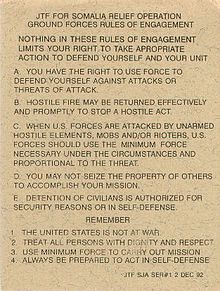Rules of engagement
Internal limits, authorizations and directives on use of force in combat / From Wikipedia, the free encyclopedia
Dear Wikiwand AI, let's keep it short by simply answering these key questions:
Can you list the top facts and stats about Rules of engagement?
Summarize this article for a 10 years old
Rules of engagement (ROE) are the internal rules or directives afforded military forces (including individuals) that define the circumstances, conditions, degree, and manner in which the use of force, or actions which might be construed as provocative, may be applied.[1] They provide authorization for and/or limits on, among other things, the use of force and the employment of certain specific capabilities. In some nations, articulated ROE have the status of guidance to military forces, while in other nations, ROE constitute lawful command. Rules of engagement do not normally dictate how a result is to be achieved, but will indicate what measures may be unacceptable.[2]

While ROE is used in both domestic and international operations by some militaries, ROE is not used for domestic operations in the United States. Instead, the use of force by the U.S. military in such situations is governed by Rules for the Use of Force (RUF).
An abbreviated description of the rules of engagement may be issued to all personnel. Commonly referred to as a "ROE card", this document provides the soldier with a summary of the ROE regulating the use of force for a particular mission.[3]